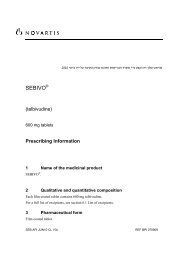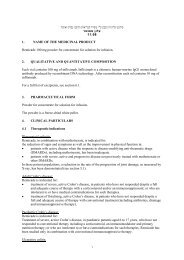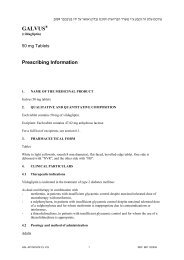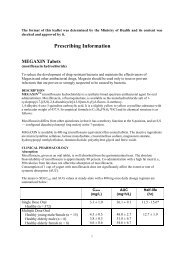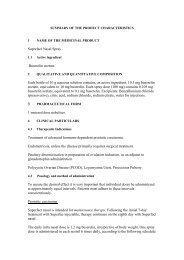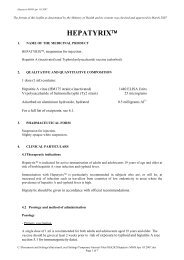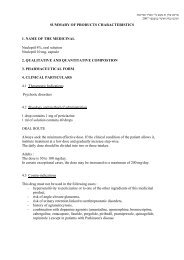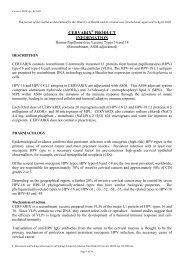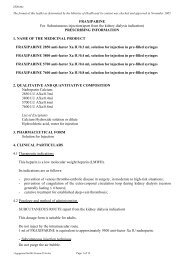Clexane Pre-filled Syringes and Multi dose Vial
Clexane Pre-filled Syringes and Multi dose Vial
Clexane Pre-filled Syringes and Multi dose Vial
You also want an ePaper? Increase the reach of your titles
YUMPU automatically turns print PDFs into web optimized ePapers that Google loves.
<strong>Pre</strong>scribing Information<br />
2009 טסוגואב רשואו קדבנ ונכותו תואירבה דרשמ י"<br />
ע עבקנ הז ןולע טמרופ<br />
<strong>Clexane</strong> <strong>Pre</strong>-<strong>filled</strong> <strong>Syringes</strong> <strong>and</strong> <strong>Multi</strong> <strong>dose</strong> <strong>Vial</strong><br />
1. NAME OF THE MEDICINAL PRODUCT<br />
<strong>Clexane</strong> <strong>Syringes</strong><br />
<strong>Clexane</strong> Forte <strong>Syringes</strong><br />
<strong>Clexane</strong> <strong>Multi</strong><strong>dose</strong> <strong>Vial</strong><br />
2. QUALITATIVE AND QUANTITATIVE COMPOSITION<br />
<strong>Clexane</strong> pre-<strong>filled</strong> syringes (100mg/ml)<br />
20mg Injection Enoxaparin sodium 20mg (equivalent to 2,000 IU anti-Xa activity)<br />
in 0.2ml water for injections<br />
40mg Injection Enoxaparin sodium 40mg (equivalent to 4,000 IU anti-Xa activity)<br />
in 0.4ml water for injections<br />
60mg Injection Enoxaparin sodium 60mg (equivalent to 6,000 IU anti-Xa activity)<br />
in 0.6ml water for injections<br />
80mg Injection Enoxaparin sodium 80mg (equivalent to 8,000 IU anti-Xa activity)<br />
in 0.8ml water for injections<br />
100mg Injection Enoxaparin sodium 100mg (equivalent to 10,000 IU anti-Xa<br />
activity) in 1.0 ml water for injections<br />
<strong>Clexane</strong> Forte pre-<strong>filled</strong> <strong>Syringes</strong> (150mg/ml)<br />
120mg Injection Enoxaparin sodium 120mg (equivalent to 12,000 IU anti-Xa<br />
activity) in 0.8ml water for injections<br />
150mg Injection Enoxaparin sodium 150mg (equivalent to 15,000 IU anti-Xa<br />
activity) in 1.0ml water for injections<br />
<strong>Clexane</strong> <strong>Multi</strong><strong>dose</strong> <strong>Vial</strong> (100mg/ml)<br />
<strong>Vial</strong>s containing 300 mg enoxaparin (equivalent to 30,000 IU anti-Xa activity) in 3.0 ml.<br />
For a full list of the excipients see section 6.1.<br />
3. PHARMACEUTICAL FORM<br />
<strong>Pre</strong><strong>filled</strong> syringes: Solution for injection in pre<strong>filled</strong> syringes.<br />
<strong>Multi</strong><strong>dose</strong> vial: Sterile pyrogen-free solution for injection contained in a multi<strong>dose</strong> vial for<br />
single patient use.<br />
4. CLINICAL PARTICULARS<br />
4.1 Therapeutic indications<br />
Enoxaparin is a low molecular weight heparin (LMWH)<br />
Enoxaparin sodium is an anti-coagulant.<br />
1
CLEXANE Solution for injection at 20mg <strong>and</strong> 40mg:<br />
- Prophylactic treatment of thrombo-embolic disorders of venous origin <strong>and</strong> in particular in<br />
orthopedic surgery or in general surgery.<br />
- <strong>Pre</strong>vention of thrombus formation in the extra-corporeal circulation during<br />
hemodialysis.<br />
CLEXANE Solution for injection at 40mg:<br />
- Prophylactic treatment of deep vein thrombosis (DVT) in patients who<br />
are bedridden due to an acute medical disorder :<br />
- Heart failure ( NYHA class III or IV )<br />
- Acute respiratory failure<br />
- Episode of acute infection or acute rheumatic disorder combined with at least one<br />
other venous thromboembolic risk factor .<br />
CLEXANE Solution for injection at 60mg, 80mg <strong>and</strong> 100mg:<br />
- Treatment of deep vein thrombosis (DVT).<br />
- Treatment of unstable angina <strong>and</strong> non-Q-wave myocardial infarction, administered<br />
concurrently with aspirin.<br />
- Treatment of pulmonary embolism.<br />
- Treatment of acute ST-segment elevation myocardial infarction, in combination with a<br />
thrombolytic agent in patients eligible or not for subsequent coronary angioplasty.<br />
CLEXANE FORTE Solution for injection at 120mg <strong>and</strong> 150mg:<br />
-Treatment of deep vain thrombosis (DVT) once daily.<br />
-Treatment of pulmonary embolism once daily.<br />
CLEXANE MULTIDOSE VIALS 100mg/ml<br />
Treatment of acute ST-segment elevation myocardial infarction, in combination with a<br />
thrombolytic agent in patients eligible or not for subsequent coronary angioplasty.<br />
4.2 Posology <strong>and</strong> method of administration<br />
SUBCUTANEOUS ROUTE (except for patients undergoing hemodialysis <strong>and</strong> in patients with<br />
acute ST-segment elevation myocardial infarction, in whom IV bolus administration is<br />
required.<br />
This presentation is suitable for adults.<br />
This drug is not to be injected via the intramuscular route.<br />
• <strong>Clexane</strong> 100mg/ml - One milliliter of solution for injection is equivalent to<br />
approximately 10 000 anti-Xa IU of enoxaparin.<br />
• <strong>Clexane</strong> Forte 150mg/ml - One milliliter of solution for injection is equivalent to<br />
approximately 15 000 anti-Xa IU of enoxaparin.<br />
<strong>Pre</strong><strong>filled</strong> syringes<br />
Subcutaneous injection technique:<br />
The pre<strong>filled</strong> syringe is ready for immediate use; no air should be expelled before<br />
administering the injection.<br />
2
Enoxaparin should be administered by injection into the subcutaneous tissue, preferably with<br />
the patient supine. Administration should be alternated between the left <strong>and</strong> right<br />
anterolateral <strong>and</strong> posterolateral abdominal walls.<br />
The whole length of the needle should be inserted perpendicularly, not from the side, into a<br />
skin fold held between the thumb <strong>and</strong> forefinger. This skin fold should be held throughout<br />
the injection.<br />
General recommendation<br />
Regular monitoring of the platelet count is essential throughout the treatment due to the risk<br />
of heparin-induced thrombocytopenia (HIT) (see Section 4.4).<br />
<strong>Multi</strong> Dose <strong>Vial</strong><br />
The correct amount for injection should be withdrawn from the vial using a graduated syringe<br />
<strong>and</strong> a needle adapted to the subcutaneous administration.<br />
With multi<strong>dose</strong> vials, it is recommended to use very fine-gauge needles (maximum diameter<br />
of 0.5 mm).<br />
Intravenous (bolus) injection technique / Using the multi<strong>dose</strong> vial of <strong>Clexane</strong><br />
300mg (30 000 anti-Xa IU) /3 mI for the treatment of acute ST-segment<br />
elevation myocardial infarction<br />
Treatment is initiated with an IV bolus injection, immediately followed by an SC<br />
injection. The multi<strong>dose</strong> vial should be used to allow the initial <strong>dose</strong> of 30mg<br />
(3 000 IU), i.e. 0.3 ml to be withdrawn using a graduated 1 ml syringe (insulintype<br />
syringe).<br />
This <strong>dose</strong> of enoxaparin should be injected into a venous line, <strong>and</strong> must not be mixed or<br />
administered with other medicinal products. To avoid any traces of other medicinal products<br />
<strong>and</strong> therefore to prevent them from mixing with enoxaparin, the injection line must be rinsed<br />
with a sufficient quantity of normal saline or glucose solution before <strong>and</strong> after IV bolus<br />
injection of enoxaparin. Enoxaparin can be safely administered with 0.9% normal saline<br />
solution or 5% glucose solution.<br />
In the hospital setting, the multi<strong>dose</strong> vial can be used to:<br />
• obtain the required 1mg(100 IU)/kg <strong>dose</strong> for the first SC injection, to be given<br />
along with the IV bolus, <strong>and</strong> then the required 1mg(100 IU)/kg <strong>dose</strong>s for SC<br />
injection, repeated every 12 hours,<br />
• obtain the 0.3mg(30 IU)/kg <strong>dose</strong> for IV bolus injection for patients<br />
undergoing subsequent coronary angioplasty.<br />
Dosage per indication<br />
Prophylactic treatment of venous thromboembolic disease in surgery<br />
As a general rule, these recommendations apply to surgical procedures carried out under<br />
general anesthesia.<br />
For spinal <strong>and</strong> epidural anesthesia techniques, the benefit of a pre-operative injection of<br />
enoxaparin should be weighed against the theoretically increased risk of spinal hematoma<br />
(see Section 4.4).<br />
• Administration schedule<br />
One injection daily.<br />
• Dose<br />
The <strong>dose</strong> must be determined based on the individual risk related to the patient <strong>and</strong> the<br />
type of surgery.<br />
o Surgery involving moderate thrombogenic risk:<br />
3
In surgery involving moderate thrombogenic risk <strong>and</strong> in patients who are not at high<br />
risk of thromboembolism, effective prevention is achieved by daily injection of 20mg<br />
(2000 anti-Xa IU , 0.2 ml).<br />
The studied dosage regimen involves administration of the first injection 2 hours<br />
before surgery.<br />
o Surgery involving high thrombogenic risk:<br />
Hip <strong>and</strong> knee surgery:<br />
The dosage is 40mg (4 000 anti-Xa IU , 0.4 ml) injected once daily.<br />
The studied dosage regimen involves either administration of the first injection<br />
of 40mg (4 000 anti-Xa IU) (total <strong>dose</strong>) twelve hours before surgery, or a first<br />
injection of 20mg (2 000 anti-Xa IU) (half <strong>dose</strong>) 2 hours before surgery.<br />
Other situations:<br />
When there appears to be an increased risk of venous thromboembolism due<br />
to the type of surgery (particularly cancer surgery) <strong>and</strong>/or due to the patient<br />
(particularly history of venous thromboembolism), administering a prophylactic<br />
<strong>dose</strong> identical to that for high-risk orthopedic surgery, such as hip or knee<br />
surgery, can be considered.<br />
• Duration of treatment<br />
Treatment with LMWH should be maintained, along with the usual methods<br />
of elastic support of the legs, until the patient is fully <strong>and</strong> actively ambulatory:<br />
o in general surgery, the duration of LMWH treatment must be less than 10 days<br />
unless there is a patient-specific risk of venous thromboembolism (see Section 4.4);<br />
o the therapeutic benefit of prophylactic treatment consisting of an injection of<br />
40mg (4 000 anti-Xa IU)/day of enoxaparin for 4 to 5 weeks after hip surgery has<br />
been established;<br />
o if the patient is still at risk of venous thromboembolism after the recommended<br />
treatment duration, continuing prophylactic therapy must be considered, particularly<br />
by administration of oral anticoagulants;<br />
However, the clinical benefit of long-term treatment with low-molecular-weight heparins or<br />
oral anticoagulants has not yet been evaluated.<br />
<strong>Pre</strong>vention of clotting in the extracorporeal circulation/hemodialysis<br />
INJECTION BY THE INTRAVASCULAR ROUTE (in the arterial line of the dialysis circuit).<br />
In patients undergoing repeated hemodialysis sessions, prevention of clotting in the<br />
extrarenal purification system is obtained by injecting an initial <strong>dose</strong> of 1mg<br />
(100 anti-Xa IU)/kg in the arterial line of the dialysis circuit at the beginning of the session.<br />
This <strong>dose</strong>, administered as a single intravascular bolus injection, is only suitable for<br />
hemodialysis sessions of 4 hours or less. It may be adjusted subsequently given high inter-<br />
<strong>and</strong> intra-individual variability.<br />
The maximum recommended <strong>dose</strong> is 1mg (100 anti-Xa IU)/kg.<br />
In hemodialysis patients at high risk of hemorrhage (particularly pre- <strong>and</strong> post-operative<br />
dialysis) or with active hemorrhage, dialysis sessions may be carried out using a <strong>dose</strong> of<br />
0.5mg (50 anti-Xa IU)/kg (double vascular access) or 0.75mg (75 anti-Xa IU)/kg (single<br />
vascular access).<br />
Curative treatment of deep vein thrombosis (DVT), with or without pulmonary embolism,<br />
without signs of clinical severity<br />
Any suspected deep vein thrombosis should be quickly confirmed by the appropriate<br />
examinations.<br />
• Administration schedule<br />
Enoxaparin sodium can be administered subcutaneously either as a single injection of<br />
1.5mg/kg or as twice daily injections of 1 mg/kg.<br />
4
• Dose<br />
The <strong>dose</strong> per injection is 1mg (100 anti-Xa IU)/kg twice daily or 1.5mg (150 anti-<br />
Xa IU)/kg as a single injection.<br />
LMWH dosage has not been evaluated in terms of bodyweight in patients weighing more<br />
than 100 kg or less than 40 kg. The efficacy of LMWH treatment may be slightly lower in<br />
patients weighing more than 100 kg, <strong>and</strong> the risk of hemorrhage may be higher in patients<br />
weighing less than 40 kg. Specific clinical monitoring must be carried out in these patients.<br />
• DVT treatment duration<br />
Treatment with low-molecular-weight heparin should be quickly replaced by oral<br />
anticoagulant therapy, unless contraindicated. Treatment duration with LMWH should not<br />
exceed 10 days, including the time needed to reach the required oral anticoagulant<br />
effect, except when this is difficult to achieve (see Section 4.4). Oral anticoagulant<br />
treatment should therefore be initiated as soon as possible.<br />
Curative treatment of unstable angina/non-Q-wave myocardial infarction<br />
A <strong>dose</strong> of 1mg (100 anti-Xa IU)/kg of enoxaparin is administered by subcutaneous injection<br />
twice daily at 12-hour intervals, in combination with aspirin (recommended <strong>dose</strong>s: 75 to 325<br />
mg orally, following a minimum loading <strong>dose</strong> of 160 mg).<br />
The recommended duration of treatment is about 2 to 8 days, until the patient is clinically<br />
stable.<br />
Treatment of acute ST-segment elevation myocardial infarction in combination with a<br />
thrombolytic agent in patients eligible or not for subsequent coronary angioplasty<br />
An initial IV bolus injection of 30mg(3 000 anti-Xa IU) followed by an SC injection of 1mg(100<br />
anti-Xa IU/kg) within 15 minutes, then every 12 hours (a maximum of 100mg(10 000 anti-Xa<br />
IU) for the first two SC <strong>dose</strong>s).<br />
The first <strong>dose</strong> of enoxaparin should be administered at any time between 15 minutes before<br />
<strong>and</strong> 30 minutes after the start of thrombolytic treatment (whether fibrin-specific or not).<br />
The recommended duration of treatment is 8 days, or until the patient is discharged from<br />
hospital if the hospitalization period is less than 8 days.<br />
Concomitant treatment: administration of aspirin must be instituted as soon as possible after<br />
symptoms appear, <strong>and</strong> maintained at a dosage of between 75 mg <strong>and</strong> 325 mg daily for at<br />
least 30 days, unless otherwise indicated.<br />
Patients treated by coronary angioplasty:<br />
- if the last SC injection of enoxaparin was performed less than 8 hours before balloon<br />
inflation, no additional administration is necessary.<br />
- if the last SC injection was performed more than 8 hours before balloon inflation, an IV<br />
bolus of 0.3mg(30 anti-Xa IU)/kg of enoxaparin must be administered. In order to improve<br />
the accuracy of the volumes to be injected, it is recommended to dilute the drug to<br />
3mg(300 IU)/ml (i.e. 0.3 ml of enoxaparin diluted in 10 ml) (see table below).<br />
5
Weight<br />
Volumes to inject when dilution is performed for coronary angioplasty patients:<br />
Required <strong>dose</strong><br />
Kg Mg (IU) ml<br />
45 13.5mg (1350 IU) 4.5<br />
50 15mg (1500 IU) 5<br />
55 16.5mg (1650 IU) 5.5<br />
60 18mg (1800 IU) 6<br />
65 19.5mg (1950 IU)) 6.5<br />
70 21mg (2100 IU) 7<br />
75 22.5mg (2250 IU) 7.5<br />
80 24mg (2400 IU) 8<br />
85 25.5mg (2550 IU) 8.5<br />
90 27mg (2700 IU) 9<br />
95 28.5mg (2850 IU) 9.5<br />
100 30mg (3000 IU) 10<br />
Volume to inject when diluted to 3mg(300 IU/ml)<br />
(i.e. 0.3 ml of enoxaparin diluted in 10 ml)<br />
In patients aged 75 <strong>and</strong> over, treated for acute ST-segment elevation myocardial infarction:<br />
The initial IV bolus injection should not be administered. An SC <strong>dose</strong> of 0.75mg(75 anti-Xa<br />
IU)/kg every 12 hours should be administered (maximum of 75mg(7 500 anti-Xa IU) for the<br />
first two injections only).<br />
Special populations<br />
Elderly<br />
For treatment of acute ST-segment Elevation Myocardial Infarction in elderly patients ≥75<br />
years of age, do not use an initial IV bolus. Initiate dosing with 0.75 mg/kg SC every 12<br />
hours (maximum 75 mg for the first two <strong>dose</strong>s only, followed by 0.75 mg/kg dosing for the<br />
remaining <strong>dose</strong>s; see Clinical Trials: Acute ST-segment Elevation Myocardial Infarction).<br />
No <strong>dose</strong> reduction is necessary in the elderly for other indications, unless renal function is<br />
impaired, however careful clinical observation is advised (see section 4.4).<br />
Children: Not recommended, as dosage not established.<br />
Renal impairment: (See also section 4.4 <strong>and</strong> 5.2)<br />
- Severe renal impairment:<br />
A dosage adjustment is required for patients with severe renal impairment (creatinine<br />
clearance < 30 ml/min), according to the following tables, since enoxaparin sodium exposure<br />
is significantly increased in this patient population:<br />
The following dosage adjustments are recommended for the prophylactic dosage ranges.<br />
Normal Dosing Severe renal impairment<br />
40 mg SC once daily 20 mg SC once daily<br />
20 mg SC once daily 20 mg SC once daily<br />
6
The following dosage adjustments are recommended for the treatment dosage ranges.<br />
Normal Dosing Severe renal impairment<br />
1 mg/kg SC twice daily 1 mg/kg SC once daily<br />
1.5 mg/kg SC once daily 1 mg/kg SC once daily<br />
Acute STEMI patients < 75 years of age<br />
30 mg-single IV bolus plus a 1 mg/kg SC <strong>dose</strong> 30 mg-single IV bolus plus a 1 mg/kg SC <strong>dose</strong><br />
followed by 1 mg/kg SC twice daily<br />
followed by 1 mg/kg SC once daily<br />
Acute STEMI patients ≥ 75 years of age<br />
0.75 mg/kg SC twice daily without initial bolus 1 mg/kg SC once daily without initial bolus<br />
The recommended dosage adjustments do not apply to the hemodialysis indication.<br />
- Moderate <strong>and</strong> Mild Renal impairment:<br />
Although no dosage adjustment are recommended in patients with moderate renal<br />
impairment (creatinine clearance 30-50 ml/min) or mild renal impairment (creatinine<br />
clearance 50-80 ml/min), careful clinical monitoring is advised.<br />
Hepatic impairment: In the absence of clinical studies, caution should be exercised.<br />
Body weight:<br />
No dosage adjustments are recommended in obesity or low body weight (see also section 4.4<br />
Special warnings <strong>and</strong> precautions for use: Low body weight <strong>and</strong> Monitoring; section 5.2<br />
Pharmacokinetic properties).<br />
4.3 CONTRAINDICATIONS<br />
Regardless of the <strong>dose</strong> (curative or preventive), this medicinal product MUST NOT<br />
BE USED in the following situations:<br />
• Hypersensitivity to enoxaparin, heparin or its derivatives, including the other LMWHs<br />
• History of serious type II heparin-induced thrombocytopenia (HIT), whether caused by<br />
unfractionated or low-molecular-weight heparin (see Section 4.4)<br />
• Bleeding or tendency to bleed related to impaired hemostasis (a possible exception to this<br />
contraindication may be disseminated intravascular coagulation, when not related to heparin<br />
treatment (see Section 4.4)<br />
• Organic lesion likely to bleed<br />
• Clinically significant active bleeding<br />
• For the <strong>Multi</strong> Dose <strong>Vial</strong> presentation: <strong>Pre</strong>mature <strong>and</strong> full-term neonates, due to the benzyl<br />
alcohol content.<br />
At curative <strong>dose</strong>s, this medicinal product MUST NOT BE USED in the following<br />
situations:<br />
• Intracerebral hemorrhage<br />
• Spinal or epidural anesthesia must never be performed in patients under curative LMWH<br />
treatment.<br />
At curative <strong>dose</strong>s, this medicinal product is GENERALLY NOT RECOMMENDED in<br />
the following cases:<br />
• Acute extensive ischemic stroke, with or without impaired consciousness.<br />
If the stroke is caused by embolism, enoxaparin must not be administered for 72 hours<br />
following the event.<br />
The efficacy of curative <strong>dose</strong>s of LMWH has however not yet been established, regardless<br />
of the cause, extent or clinical severity of cerebral infarction.<br />
• Acute infectious endocarditis (except for some emboligenic cardiac conditions)<br />
7
In addition, at curative <strong>dose</strong>s, this drug should preferably not be used in all subjects,<br />
regardless of age, when combined with the following (see Section 4.5):<br />
1. Acetylsalicylic acid at analgesic, antipyretic <strong>and</strong> anti-inflammatory <strong>dose</strong>s,<br />
2. NSAIDs (systemic use),<br />
3. Dextran 40 (parenteral use).<br />
At prophylactic <strong>dose</strong>s, this medicinal product is GENERALLY NOT RECOMMENDED<br />
in the following situations:<br />
• during the first 24 hours following intracerebral hemorrhage.<br />
In addition, at prophylactic <strong>dose</strong>s, this drug should preferably not be used in subjects<br />
over 65 years of age when used in combination with (see Section 4.5):<br />
1. Acetylsalicylic acid at analgesic, antipyretic <strong>and</strong> anti-inflammatory <strong>dose</strong>s,<br />
2. NSAIDs (systemic use),<br />
3. Dextran 40 (parenteral use).<br />
4.4 Special warnings <strong>and</strong> special precautions for use<br />
Although the concentrations of the various low-molecular-weight heparins are all expressed<br />
in anti-Xa international units (IU), their efficacy is not only related to their anti-Xa activity. It<br />
would be dangerous to replace one LMWH dosage regimen by another as each regimen has<br />
been validated by specific clinical studies. Particular care is therefore required <strong>and</strong> the specific<br />
instructions for use of each drug must be followed.<br />
For the <strong>Multi</strong> Dose <strong>Vial</strong> presentation: As this medicinal product contains 15 mg/ml benzyl<br />
alcohol, it may cause toxic or anaphylactoid reactions in infants <strong>and</strong> children under 3 years of<br />
age.<br />
Special warnings<br />
Risk of hemorrhage<br />
The recommended dosage regimens must be respected (dosage <strong>and</strong> duration of treatment).<br />
Failure to comply with these recommendations can lead to hemorrhage, particularly in highrisk<br />
patients (the elderly, patients with renal failure, etc.)<br />
Serious hemorrhagic events have been reported in the following situations:<br />
• elderly subjects, particularly due to age-related renal impairment,<br />
• patients with renal failure,<br />
• bodyweight below 40 kg,<br />
• treatment lasting longer than the recommended mean duration of ten days,<br />
• non-compliance with treatment recommendations (particularly treatment duration <strong>and</strong> <strong>dose</strong><br />
adjustment based on bodyweight in curative treatment),<br />
• co-administration with drugs increasing the risk of hemorrhage (see Section 4.5).<br />
In any event, special monitoring is essential in the elderly <strong>and</strong>/or patients with renal failure,<br />
as well as during treatment prolonged beyond ten days.<br />
Assay of anti-Xa activity may in certain cases be useful in detecting drug accumulation.<br />
Risk of heparin-induced thrombocytopenia (HIT)<br />
Should a patient treated with LMWH (at curative or preventive <strong>dose</strong>s) develop thrombotic<br />
complications such as:<br />
• exacerbation of the thrombosis being treated,<br />
• phlebitis,<br />
• pulmonary embolism,<br />
• acute ischemia of the lower limbs,<br />
• or even myocardial infarction or ischemic stroke,<br />
HIT should systematically be suspected <strong>and</strong> a platelet count performed urgently.<br />
8
Use in children<br />
As no relevant data are available, use of LMWH is not recommended in children.<br />
Mechanical prosthetic heart valves<br />
Use of enoxaparin in the prevention of thromboembolic complications in patients with<br />
mechanical prosthetic heart valves has not specifically been studied.<br />
Nevertheless, some isolated cases of thrombosis have been reported in patients with<br />
mechanical prosthetic heart valves receiving enoxaparin for the prevention of<br />
thromboembolic complications.<br />
<strong>Pre</strong>gnant women<br />
In a clinical study in pregnant women with mechanical prosthetic heart valves who received<br />
1mg (100 anti-Xa IU)/kg enoxaparin b.i.d. to reduce the risk of thromboembolic<br />
complications, 2 of 8 women developed thrombosis causing valve obstruction leading to<br />
maternal <strong>and</strong> fetal death. Moreover, isolated cases of thrombosis in pregnant women with<br />
mechanical prosthetic heart valves receiving enoxaparin for the prevention of<br />
thromboembolic complications have been reported as part of post-marketing surveillance of<br />
the drug. Therefore, the risk of thromboembolic complications in these patients could be<br />
higher.<br />
<strong>Pre</strong>cautions for use<br />
Hemorrhage<br />
As with all anticoagulants, bleeding can occur (see Section 4.8). If bleeding occurs, the origin<br />
of the hemorrhage must be investigated <strong>and</strong> appropriate treatment instituted.<br />
Renal function<br />
Before low-molecular-weight heparin treatment is initiated, it is essential to evaluate renal<br />
function, particularly in subjects 75 years or older, by determining creatinine clearance (Clcr),<br />
using the Cockcroft formula <strong>and</strong> based on a recent bodyweight measurement:<br />
In male patients: Clcr = (140-age) × weight / (0.814 × serum creatinine) where age is<br />
expressed in years, weight in kg <strong>and</strong> serum creatinine in μmol/l.<br />
This formula must be adjusted for female patients by multiplying the result by 0.85.<br />
When serum creatinine is expressed in mg/l, the value should be multiplied by a factor of 8.8.<br />
Laboratory tests<br />
• Platelet monitoring<br />
Heparin-induced thrombocytopenia (HIT)<br />
There is a risk of serious, occasionally thrombogenic, heparin-induced thrombocytopenia<br />
(reported with unfractionated heparin <strong>and</strong> less often with LMWH) of immunologic origin,<br />
called type II HIT (see also Section 4.8).<br />
As a result of this risk, platelet counts must be performed regardless of the therapeutic<br />
indication <strong>and</strong> the <strong>dose</strong> administered.<br />
Platelet counts must be performed before administration or at the latest within 24 hours of<br />
initiating treatment, then twice a week during the usual treatment duration.<br />
9
Should long-term treatment prove necessary in certain specific cases (i.e. hip surgery, second<br />
<strong>and</strong> third trimesters of high-risk pregnancy (see Section 4.6)), the platelet counts should be<br />
performed twice a week during the first month of treatment (highest risk period) <strong>and</strong> then<br />
once a week, until treatment discontinuation.<br />
HIT should be suspected when the platelet count is below 100 000/mm 3 <strong>and</strong>/or when there is<br />
a drop of 30% to 50% between two successive platelet counts. HIT mainly develops 5 to 21<br />
days after heparin treatment is instituted (with a peak incidence after about 10 days).<br />
This complication can however occur much earlier in patients with a history of heparininduced<br />
thrombocytopenia, <strong>and</strong> isolated cases have been reported after 21 days. This type of<br />
patient history must therefore be systematically investigated by means of an in-depth<br />
interview before starting treatment.<br />
Furthermore, the risk of recurrence when reinstituting heparin may remain for several years<br />
or even indefinitely (see Section 4.3).<br />
In all cases, the occurrence of HIT constitutes an emergency situation <strong>and</strong> requires a<br />
specialist opinion.<br />
Any significant drop in the platelet count (30% to 50% versus baseline) is a warning sign<br />
even before values reach a critical level. Should a decrease in platelets be observed, the<br />
following must be performed in all cases:<br />
1) - an immediate platelet count for verification,<br />
2) - discontinuation of heparin treatment, if the drop is confirmed or even increased based on<br />
these results <strong>and</strong> when no other obvious cause is identified.<br />
A sample must be taken using a citrate tube in order to perform in vitro platelet aggregation<br />
<strong>and</strong> immunological tests. However, under these conditions, the immediate measures to be<br />
taken are not based on in vitro platelet aggregation or immunological test results as only a<br />
few specialized laboratories perform these tests routinely <strong>and</strong> the results are available at best<br />
after several hours. These tests are however necessary to assist in diagnosis of the<br />
complication as the risk of thrombosis is very high if heparin treatment is continued.<br />
3) - prevention or treatment of HIT-related thrombotic complications.<br />
If continued anticoagulant therapy appears to be essential, heparin must be replaced by an<br />
antithrombotic agent of a different group such as sodium danaparoid or hirudin, prescribed at<br />
curative or preventive <strong>dose</strong>s on a case-by-case basis.<br />
Replacement by oral anticoagulants can only take place after the platelet count has reverted<br />
to normal due to the risk of exacerbation of thrombosis by oral anticoagulants.<br />
• Replacement of heparin by oral anticoagulants<br />
Clinical monitoring <strong>and</strong> laboratory tests (prothrombin time expressed as the INR) must<br />
be intensified to monitor the effect of oral anticoagulants.<br />
As there is an interval before the oral anticoagulant reaches its maximum effect, heparin<br />
therapy should be continued at a constant <strong>dose</strong> for as long as necessary in order to maintain<br />
INR within the desired therapeutic range, for the indication in two successive tests.<br />
• Monitoring of anti-factor Xa activity<br />
As most of the clinical studies which demonstrated the efficacy of LMWH were conducted<br />
using a <strong>dose</strong> based on bodyweight without specific laboratory monitoring, the usefulness<br />
of laboratory tests for assessing the efficacy of LMWH treatment has not been established.<br />
However,laboratory tests, i.e. monitoring of anti-Xa activity may be useful in managing the<br />
risk of bleeding in certain clinical conditions often associated with a risk of over<strong>dose</strong>.<br />
10
These situations mainly involve the curative indications of LMWH, due to the <strong>dose</strong>s<br />
administered, in patients with:<br />
o severe <strong>and</strong> mild to moderate renal failure (creatinine clearance of approximately 30 ml/min<br />
to 60 ml/min calculated using the Cockroft formula). As LMWH is primarily eliminated by<br />
the renal route, unlike st<strong>and</strong>ard unfractionated heparin, any renal failure can result in<br />
relative over<strong>dose</strong>.<br />
o extreme high or low bodyweight (thinness or even cachexia, obesity);<br />
o unexplained bleeding.<br />
In contrast, laboratory monitoring is not recommended at prophylactic <strong>dose</strong>s if the<br />
LMWH treatment complies with the therapeutic recommendations (particularly treatment<br />
duration), nor during hemodialysis.<br />
To detect possible heparin accumulation following repeated administration, it<br />
is recommended, if necessary, to collect a blood sample at peak activity (based on available<br />
data), i.e. approximately 4 hours after the third injection when the drug is given as<br />
2 subcutaneous injections per day.<br />
Repeating anti-Xa activity assays to determine blood heparin levels, for example every 2 to 3<br />
days, should be decided on a case-by-case basis, depending on the results of the preceding<br />
assay, <strong>and</strong> a possible LMWH <strong>dose</strong> adjustment should be considered.<br />
The anti-Xa activity observed varies for each LMWH <strong>and</strong> each dosage regimen.<br />
For information, based on available data, the mean value (± st<strong>and</strong>ard deviation) observed<br />
4 hours after the 7 th injection of enoxaparin given at a <strong>dose</strong> of 1mg (100 anti-Xa<br />
IU)/kg/injection b.i.d. was 1.20 ± 0.17 anti-Xa IU/ml.<br />
This mean value was observed during clinical trials for anti-Xa activity assays carried out by a<br />
chromogenic method (amidolytic).<br />
• Activated partial thromboplastin time (aPTT)<br />
Some LMWHs moderately increase aPTT. As no clinical relevance has been established,<br />
monitoring of treatment using this test is of no use.<br />
Spinal/epidural anesthesia in patients given preventive treatment with LMWH<br />
• As with other anticoagulants, rare cases of spinal hematomas have been reported with<br />
LMWHs during spinal/epidural anesthesia, resulting in long-term or permanent paralysis.<br />
The risk of spinal hematoma appears to be higher in epidural anesthesia with a catheter<br />
than spinal anesthesia.<br />
The risk of these rare events may be increased by prolonged post-operative use of epidural<br />
catheters.<br />
• If pre-operative LMWH treatment is required (long-term bedridden patients, trauma), <strong>and</strong> if<br />
the benefit of local/regional spinal anesthesia has been carefully weighed, patients who<br />
received a pre-operative injection of LMWH can be anesthetized, provided that an interval<br />
of at least 12 hours is respected between the heparin injection <strong>and</strong> the spinal anesthesia.<br />
Close neurological monitoring is recommended due to the risk of spinal hematoma.<br />
In almost all patients, prophylactic treatment with LMWH can be initiated within 6 to 8<br />
hours after the anesthesia or removal of the catheter, under neurological monitoring.<br />
Particular caution should be exercised during co-administration with other drugs that affect<br />
hemostasis (specifically non-steroidal anti-inflammatory drugs, aspirin).<br />
Situations involving particular risk<br />
Monitoring of treatment should be intensified in the following cases:<br />
• hepatic insufficiency,<br />
• history of gastro-intestinal ulcers or any other organic lesion likely to bleed,<br />
• chorioretinal vascular disease,<br />
• post-operatively, following cerebral or spinal cord surgery,<br />
• lumbar puncture: this should only be considered taking into account the risk of intra-spinal<br />
bleeding <strong>and</strong> should be postponed whenever possible,<br />
• concomitant use of medicinal products affecting hemostasis (see Section 4.5).<br />
11
Coronary angioplasty revascularization procedure<br />
To minimize the risk of hemorrhage during coronary angioplasty for unstable angina, non-Qwave<br />
myocardial infarction <strong>and</strong> acute ST-segment elevation myocardial infarction, it is<br />
recommended that the advised intervals between enoxaparin injections be strictly complied<br />
with. It is important to perform hemostasis at the vascular puncture site following coronary<br />
angioplasty. If an occlusion device is used, the introducer can be removed immediately. If<br />
manual compression is performed, the introducer must be removed 6 hours after the last<br />
SC/IV injection of enoxaparin. If enoxaparin treatment is continued, the following injection<br />
must be performed at the earliest 6 to 8 hours after removal of the introducer. The puncture<br />
site must be monitored to detect any signs of bleeding or hematoma.<br />
4.5 Interactions with other medicinal products <strong>and</strong> other forms of interaction<br />
Certain drugs or therapeutic classes may promote the occurrence of hyperkalemia: potassium<br />
salts, potassium-sparing diuretics, conversion enzyme inhibitors, angiotensin II inhibitors,<br />
non-steroidal anti-inflammatory drugs, heparins (low-molecular-weight or unfractionated<br />
heparin), ciclosporin <strong>and</strong> tacrolimus, trimethoprim.<br />
Occurrence of hyperkalemia may depend on possible related risk factors.<br />
This risk is potentiated when the above-mentioned drugs are co-administered.<br />
• Patients under 65 years of age receiving curative LMWH <strong>dose</strong>s <strong>and</strong> elderly<br />
patients (more than 65 years) regardless of the LMWH <strong>dose</strong><br />
Inadvisable combinations<br />
+ Acetylsalicylic acid at analgesic, antipyretic <strong>and</strong> anti-inflammatory <strong>dose</strong>s (<strong>and</strong>,<br />
by extrapolation, other salicylates):<br />
Increased risk of bleeding (salicylate-induced platelet function inhibition <strong>and</strong><br />
gastroduodenal mucosal damage).<br />
Use a non-salicylate antipyretic analgesic (such as paracetamol).<br />
+ NSAIDs (systemic use):<br />
Increased risk of bleeding (NSAID-induced platelet function inhibition <strong>and</strong> gastroduodenal<br />
mucosal damage).<br />
If co-administration cannot be avoided, close clinical monitoring is required.<br />
+ Dextran 40 (parenteral use) :<br />
Increased risk of bleeding (inhibition of platelet function by dextran 40).<br />
Combinations requiring precautions for use<br />
+ Oral anticoagulants<br />
Potentiation of the anticoagulant effect.<br />
When heparin is replaced by an oral anticoagulant, clinical monitoring must be intensified.<br />
Combinations to take into consideration<br />
+ Platelet aggregation inhibitors (other than acetylsalicylic acid at analgesic, antipyretic<br />
<strong>and</strong> anti-inflammatory <strong>dose</strong>s; NSAIDs): abciximab, acetylsalicylic acid at<br />
antiaggregant <strong>dose</strong>s in cardiological <strong>and</strong> neurological indications, beraprost,<br />
clopidogrel, eptifibatide, iloprost, ticlopidine, tirofiban.<br />
Increased risk of bleeding.<br />
• Patients under 65 years of age receiving prophylactic LMWH <strong>dose</strong>s<br />
12
Combinations to be taken into consideration<br />
Combined use of drugs affecting various stages of hemostasis potentiates the risk of<br />
bleeding. Therefore, regardless of patient age, continued clinical monitoring <strong>and</strong>, if<br />
necessary, laboratory tests must be performed when co-administering LMWHs at prophylactic<br />
<strong>dose</strong>s with oral anti-coagulants, platelet aggregation inhibitors (abciximab, NSAIDs,<br />
acetylsalicylic acid at any <strong>dose</strong>, clopidogrel, eptifibatide, iloprost, ticlopidine, tirofiban) <strong>and</strong><br />
thrombolytic agents.<br />
4.6 PREGNANCY AND LACTATION<br />
<strong>Pre</strong>gnancy<br />
There is no evidence from animal studies that enoxaparin has teratogenic effects. In the<br />
absence of any teratogenic effect in animals, no such effect is expected in man.<br />
To date, substances responsible for malformation in humans have proved to be teratogenic in<br />
animals during well-conducted studies in two species.<br />
Prophylactic treatment during the first trimester <strong>and</strong> curative treatment<br />
There are currently not enough relevant clinical data to evaluate possible teratogenic or<br />
fetotoxic effects of enoxaparain when the drug is administered prophylactically during the<br />
first trimester or at curative <strong>dose</strong>s throughout pregnancy.<br />
Consequently, as a precautionary measure, enoxaparin should preferably not be administered<br />
prophylactically during the first trimester, nor at curative <strong>dose</strong>s throughout pregnancy.<br />
If epidural anesthesia is planned, prophylactic heparin treatment should be interrupted<br />
whenever possible at the latest within 12 hours before anesthesia.<br />
Epidural or spinal anesthesia should never be performed during curative treatment with<br />
LMWH.<br />
Prophylactic treatment during the second <strong>and</strong> third trimesters<br />
To date, there seems to be no evidence from clinical use of enoxaparin in a limited number of<br />
pregnancies during the second <strong>and</strong> third trimesters, that the drug administered at<br />
prophylactic <strong>dose</strong>s has any particular teratogenic or fetotoxic effects. However, additional<br />
studies are needed to evaluate the effects of exposure under these conditions.<br />
Therefore, prophylactic enoxaparin treatment during the second <strong>and</strong> third trimesters should<br />
only be considered if necessary.<br />
If epidural anesthesia is planned, prophylactic heparin treatment should be interrupted<br />
whenever possible at the latest within 12 hours before anesthesia.<br />
Lactation<br />
Since gastro-intestinal absorption by neonates is unlikely in principle, treatment with<br />
enoxaparin is not contraindicated in breast-feeding women.<br />
4.7 EFFECTS ON ABILITY TO DRIVE AND OPERATE MACHINES<br />
Not applicable.<br />
13
4.8 UNDESIRABLE EFFECTS<br />
• Hemorrhagic manifestations<br />
This are mainly related to:<br />
* Associated risk factors: organic lesions likely to bleed <strong>and</strong> certain drug combinations<br />
(see Sections 4.3 <strong>and</strong> 4.5 ), age, renal failure, low bodyweight.<br />
* Failure to comply with therapeutic recommendations, particularly treatment duration<br />
<strong>and</strong> <strong>dose</strong> adjustment based on bodyweight (see Section 4.4).<br />
Rare cases of spinal hematoma have been reported following administration of low-<br />
molecular-weight heparin during spinal anesthesia, analgesia or epidural anesthesia.<br />
These adverse events have produced varying degrees of neurological injury, including<br />
long-term or permanent paralysis (see Section 4.4).<br />
• Possible hematomas at the injection site after subcutaneous administration. This risk is<br />
increased if the recommended injection technique is not respected or if inappropriate<br />
injection material is used. Hard nodules which disappear within a few days may develop<br />
as a result of an inflammatory reaction <strong>and</strong> do not require discontinuation of therapy.<br />
• Thrombocytopenia has been reported. There are two types:<br />
- Type I, i.e. the most common cases, usually moderate (more than<br />
100 000/mm 3 ), of early onset (before the fifth day) which do not<br />
require discontinuation of treatment,<br />
- Type II, i.e. rare serious immunoallergic thrombocytopenia (HIT). The incidence<br />
remains poorly evaluated (see Section 4.4).<br />
• Possible asymptomatic <strong>and</strong> reversible elevation of the platelet count.<br />
• Rare skin necrosis observed in most cases at the injection site has been reported with<br />
heparins. These reactions may be preceded by purpura or by infiltrated <strong>and</strong> painful<br />
erythematous plaques. Treatment must be discontinued immediately in these cases.<br />
• Rare skin or systemic allergic manifestations have occurred, possibly leading to treatment<br />
discontinuation in certain cases.<br />
• As with unfractionated heparins, the risk of osteoporosis cannot be ruled out if treatment<br />
is prolonged.<br />
• Transient elevation of transaminase levels.<br />
• A few cases of hyperkalemia have been reported.<br />
• In very rare cases, vasculitis due to skin hypersensitivity<br />
• Very rarely, hypereosinophilia, occurring in isolated cases or along<br />
with skin reactions, resolving on treatment discontinuation.<br />
4.9 OVERDOSE<br />
Accidental over<strong>dose</strong> following subcutaneous administration of massive <strong>dose</strong>s<br />
of low-molecular-weight heparin may result in hemorrhagic complications.<br />
In case of hemorrhage, certain patients can be treated with protamine sulfate, taking the<br />
following factors into account:<br />
• its efficacy is far lower than that reported in over<strong>dose</strong>s with unfractionated heparin,<br />
• due to its undesirable effects (particularly anaphylactic shock), the benefit/risk ratio of<br />
protamine sulfate should be carefully weighed beforeh<strong>and</strong>.<br />
Neutralization is performed by slow intravenous injection of protamine (sulfate or<br />
hydrochloride).<br />
The protamine <strong>dose</strong> required depends on:<br />
• the heparin <strong>dose</strong> injected (100 anti-heparin units of protamine neutralizes the activity of<br />
100 anti-Xa IU of low-molecular-weight heparin), if enoxaparin sodium was administered<br />
within the last 8 hours.<br />
• the time since the heparin injection:<br />
- an infusion of 50 anti-heparin units of protamine per 100 anti-Xa IU of enoxaparin<br />
sodium may be administered if enoxaparin sodium was given more than 8 hours<br />
previously, or if a second <strong>dose</strong> of protamine seems necessary.<br />
14
- if the injection of enoxaparin sodium was given more than 12 hours previously, it is not<br />
necessary to administer protamine.<br />
These recommendations concern patients with normal renal function receiving repeated<br />
<strong>dose</strong>s.<br />
Nevertheless, the anti-Xa activity cannot be completely neutralized.<br />
Furthermore, the neutralization may be transient due to the absorption pharmacokinetics of<br />
low-molecular-weight heparin, which may require dividing the total calculated <strong>dose</strong> of<br />
protamine into several injections (2 to 4) given over 24 hours.<br />
In principle, no serious consequences are likely after ingestion of<br />
low-molecular-weight heparin, even in massive quantities (no cases reported),<br />
due to the very low gastric <strong>and</strong> intestinal absorption of the drug.<br />
5. PHARMACOLOGICAL PROPERTIES<br />
5.1 Pharmacodynamic properties<br />
Pharmacotherapeutic group: ANTITHROMBOTIC AGENT, ATC code: B01 AB 05<br />
Enoxaparin is a low-molecular-weight heparin in which the antithrombotic<br />
<strong>and</strong> anticoagulant activities of st<strong>and</strong>ard heparin have been dissociated.<br />
It is characterized by higher anti-Xa activity than anti-IIa or antithrombin<br />
activity.<br />
For enoxaparin, the ratio between these two activities is 3.6.<br />
At prophylactic <strong>dose</strong>s, it does not significantly affect the aPTT.<br />
At curative <strong>dose</strong>s, aPTT can be prolonged by 1.5 to 2.2 times the control<br />
time at peak activity. This prolongation reflects the residual antithrombin<br />
activity.<br />
Treatment of acute ST-segment elevation myocardial infarction, in combination<br />
with a thrombolytic agent in patients who are eligible or not for subsequent<br />
coronary angioplasty.<br />
In a large multicenter study, 20 479 patients with acute ST-segment elevation myocardial<br />
infarction having received fibrinolytic treatment were r<strong>and</strong>omized to receive either:<br />
enoxaparin as an IV bolus injection of 30mg(3 000 anti-Xa IU) immediately followed by a<br />
<strong>dose</strong> of 1mg(100 anti-Xa IU)/kg SC, then by an SC injection of 1mg(100 anti-Xa IU)/kg every<br />
12 hours, or unfractionated heparin by the IV route as a bolus injection of 60 IU/kg<br />
(maximum 4 000 IU) followed by a continuous infusion at a <strong>dose</strong> adjusted to the activated<br />
partial thromboplastin time. The SC injections of enoxaparin were administered until<br />
discharge from hospital or for a maximum period of 8 days (in 75% of cases for at least 6<br />
days). Half the patients receiving heparin were administered the drug for less than 48 hours<br />
(in 89.5% of cases ≥ 36 hours). All the patients were also treated with aspirin for at least 30<br />
days. The enoxaparin dosage was adjusted for patients aged 75 years or more: 0.75mg(75<br />
IU)/kg as an SC injection every 12 hours, without an initial IV bolus injection.<br />
During the study, 4 716 (23%) patients underwent coronary angioplasty under<br />
antithrombotic treatment using blinded study drugs. Patients did not receive an additional<br />
<strong>dose</strong> if the last SC injection of enoxaparin had been given less than 8 hours before balloon<br />
inflation, or, received an IV bolus injection of 0.3mg(30 anti-Xa IU)/kg if the last SC injection<br />
of enoxaparin had been given more than 8 hours before balloon inflation.<br />
15
Enoxaparin significantly reduced the incidence of primary end point events (composite end<br />
point consisting of myocardial infarction relapse <strong>and</strong> all-cause mortality within 30 days after<br />
inclusion: 9.9% in the enoxaparin group versus 12.0% in the unfractionated heparin group<br />
(relative risk reduction of 17% (p
Plasma anti-IIa activity after subcutaneous administration is about 10-fold lower than anti-Xa<br />
activity. The mean maximum anti-IIa activity is observed approximately 3 to 4 hours<br />
following subcutaneous injection, <strong>and</strong> reaches 0.13 anti-IIa IU/ml following repeated<br />
administration of a 100 anti-Xa IU/kg <strong>dose</strong> b.i.d.<br />
No pharmacokinetic interaction has been observed between enoxaparin <strong>and</strong> the thrombolytic<br />
agent when co-administered.<br />
Distribution<br />
The volume of distribution of enoxaparin anti-Xa activity is about 5 liters <strong>and</strong> is close to the<br />
blood volume.<br />
Metabolism<br />
Enoxaparin is metabolized mainly in the liver (desulfation, depolymerization).<br />
Elimination<br />
Following subcutaneous injection, the apparent anti-Xa activity elimination half-life is higher<br />
for low-molecular-weight heparins than for unfractionated heparins.<br />
Enoxaparin exhibits a monophasic elimination pattern with a half-life of about 4 hours after a<br />
single subcutaneous <strong>dose</strong> to about 7 hours after repeated dosing.<br />
With low-molecular-weight heparin, plasma decay occurs more quickly for anti-IIa activity<br />
than for anti-Xa activity.<br />
Enoxaparin <strong>and</strong> its metabolites are eliminated via the renal route (nonsaturable mechanism)<br />
<strong>and</strong> by the biliary route.<br />
Renal clearance of fragments with anti-Xa activity accounts for about 10% of the<br />
administered <strong>dose</strong>, <strong>and</strong> total renal excretion of active <strong>and</strong> non-active compounds for 40% of<br />
the <strong>dose</strong>.<br />
5.3 <strong>Pre</strong>clinical safety data<br />
No long-term studies in animals have been performed to evaluate the carcinogenic potential<br />
of enoxaparin.<br />
Enoxaparin was not mutagenic in in vitro tests, including the Ames test, the forward mutation<br />
test at the thymidine kinase (TK) locus of L5178Y mouse lymphoma cells, <strong>and</strong> human<br />
lymphocyte chromosomal aberration test, <strong>and</strong> the in vivo rat bone marrow chromosomal<br />
aberration test.<br />
Enoxaparin was found to have no effect on fertility or reproductive performance of male <strong>and</strong><br />
female rats at SC <strong>dose</strong>s less than 20 mg/kg/day.<br />
Teratogenicity studies have been conducted in gravid rats <strong>and</strong> rabbits at SC <strong>dose</strong>s of<br />
enoxaparin less than 30 mg/kg/day.<br />
There was no evidence of teratogenic effects or fetotoxicity due to enoxaparin.<br />
Besides the anticoagulant effects of enoxaparin, there was no evidence of adverse effects<br />
during the following toxicity studies:<br />
• 15 mg/kg/day in 13-week subcutaneous toxicity studies in rats <strong>and</strong> dogs<br />
• 10 mg/kg/day in 26-week subcutaneous <strong>and</strong> intravenous toxicity studies in rats <strong>and</strong><br />
monkeys.<br />
17
6. PHARMACEUTICAL PARTICULARS<br />
6.1 List of excipients<br />
<strong>Pre</strong><strong>filled</strong> syringes : Water for injection.<br />
<strong>Multi</strong> Dose <strong>Vial</strong>s : Benzyl alcohol, water for injection<br />
6.2 Special precautions for storage<br />
Do not store above 25°C. Do not refrigerate or freeze.<br />
To be stored in the original packaging<br />
6.3 Shelf-life<br />
<strong>Multi</strong> Dose <strong>Vial</strong>s : after use for the first time, to be stored at a temperature not exceeding<br />
25°C for a maximum of 28 days.<br />
6.4 Nature <strong>and</strong> contents of outer packaging<br />
<strong>Clexane</strong> pre-<strong>filled</strong> syringes (100mg/ml)<br />
0.2 ml solution for injection in pre<strong>filled</strong> (glass) syringes<br />
0.2 ml solution for injection in pre<strong>filled</strong> (glass) syringes with safety system<br />
0.4 ml solution for injection in pre<strong>filled</strong> (glass) syringes<br />
0.4 ml solution for injection in pre<strong>filled</strong> (glass) syringes with safety system<br />
0.6 ml solution for injection in pre<strong>filled</strong> (glass) syringes<br />
0.6 ml solution for injection in pre<strong>filled</strong> (glass) syringes with safety system<br />
0.8 ml solution for injection in pre<strong>filled</strong> (glass) syringes.<br />
0.8 ml solution for injection in pre<strong>filled</strong> (glass) syringes with safety system<br />
1.0 ml solution for injection in pre<strong>filled</strong> (glass) syringes<br />
1.0 ml solution for injection in pre<strong>filled</strong> (glass) syringes with safety system<br />
<strong>Clexane</strong> Forte pre-<strong>filled</strong> <strong>Syringes</strong> (150mg/ml)<br />
0.8 ml solution for injection in pre<strong>filled</strong> (glass) syringes – box of 2 or 10.<br />
1.0 ml solution for injection in pre<strong>filled</strong> (glass) syringes – box of 2 or 10.<br />
<strong>Clexane</strong> <strong>Multi</strong><strong>dose</strong> <strong>Vial</strong> (100mg/ml)<br />
3ml injection for solution in multi<strong>dose</strong> vials – box of 1 vial<br />
6.5 Special precautions for disposal <strong>and</strong> h<strong>and</strong>ling<br />
Dispose of the product safely as instructed by your healthcare professional.<br />
For pre<strong>filled</strong> syringes with a safety system:<br />
<strong>Clexane</strong> is a solution for injection in pre<strong>filled</strong> syringes with an automatic safety system<br />
intended to prevent accidental needle sticks after injection. Instructions on how to use the<br />
device are provided in the Package Leaflet.<br />
7. Manufacturer<br />
<strong>Clexane</strong> pre-<strong>filled</strong> syringes (100mg/ml)– Sanofi Winthrop Industrie France<br />
<strong>Clexane</strong> Forte pre-<strong>filled</strong> syringes (150mg/ml)– Sanofi Winthrop Industrie France<br />
<strong>Clexane</strong> <strong>Multi</strong> Dose <strong>Vial</strong>s – Sanofi-aventis Spain<br />
8. MARKETING AUTHORIZATION HOLDER<br />
18
sanofi-aventis Israel ltd. P.O.B. 8090 Netanya 42504<br />
19



